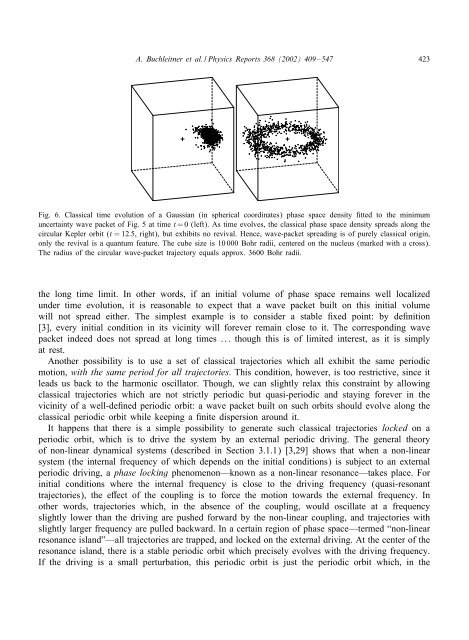Non-dispersive wave packets in periodically driven quantum systems
Non-dispersive wave packets in periodically driven quantum systems
Non-dispersive wave packets in periodically driven quantum systems
Create successful ePaper yourself
Turn your PDF publications into a flip-book with our unique Google optimized e-Paper software.
A. Buchleitner et al. / Physics Reports 368 (2002) 409–547 423<br />
Fig. 6. Classical time evolution of a Gaussian (<strong>in</strong> spherical coord<strong>in</strong>ates) phase space density tted to the m<strong>in</strong>imum<br />
uncerta<strong>in</strong>ty <strong>wave</strong> packet of Fig. 5 at time t = 0 (left). As time evolves, the classical phase space density spreads along the<br />
circular Kepler orbit (t =12:5, right), but exhibits no revival. Hence, <strong>wave</strong>-packet spread<strong>in</strong>g is of purely classical orig<strong>in</strong>,<br />
only the revival is a <strong>quantum</strong> feature. The cube size is 10 000 Bohr radii, centered on the nucleus (marked with a cross).<br />
The radius of the circular <strong>wave</strong>-packet trajectory equals approx. 3600 Bohr radii.<br />
the long time limit. In other words, if an <strong>in</strong>itial volume of phase space rema<strong>in</strong>s well localized<br />
under time evolution, it is reasonable to expect that a <strong>wave</strong> packet built on this <strong>in</strong>itial volume<br />
will not spread either. The simplest example is to consider a stable xed po<strong>in</strong>t: by de nition<br />
[3], every <strong>in</strong>itial condition <strong>in</strong> its vic<strong>in</strong>ity will forever rema<strong>in</strong> close to it. The correspond<strong>in</strong>g <strong>wave</strong><br />
packet <strong>in</strong>deed does not spread at long times ::: though this is of limited <strong>in</strong>terest, as it is simply<br />
at rest.<br />
Another possibility is to use a set of classical trajectories which all exhibit the same periodic<br />
motion, with the same period for all trajectories. This condition, however, is too restrictive, s<strong>in</strong>ce it<br />
leads us back to the harmonic oscillator. Though, we can slightly relax this constra<strong>in</strong>t by allow<strong>in</strong>g<br />
classical trajectories which are not strictly periodic but quasi-periodic and stay<strong>in</strong>g forever <strong>in</strong> the<br />
vic<strong>in</strong>ity of a well-de ned periodic orbit: a <strong>wave</strong> packet built on such orbits should evolve along the<br />
classical periodic orbit while keep<strong>in</strong>g a nite dispersion around it.<br />
It happens that there is a simple possibility to generate such classical trajectories locked on a<br />
periodic orbit, which is to drive the system by an external periodic driv<strong>in</strong>g. The general theory<br />
of non-l<strong>in</strong>ear dynamical <strong>systems</strong> (described <strong>in</strong> Section 3.1.1) [3,29] shows that when a non-l<strong>in</strong>ear<br />
system (the <strong>in</strong>ternal frequency of which depends on the <strong>in</strong>itial conditions) is subject to an external<br />
periodic driv<strong>in</strong>g, a phase lock<strong>in</strong>g phenomenon—known as a non-l<strong>in</strong>ear resonance—takes place. For<br />
<strong>in</strong>itial conditions where the <strong>in</strong>ternal frequency is close to the driv<strong>in</strong>g frequency (quasi-resonant<br />
trajectories), the e ect of the coupl<strong>in</strong>g is to force the motion towards the external frequency. In<br />
other words, trajectories which, <strong>in</strong> the absence of the coupl<strong>in</strong>g, would oscillate at a frequency<br />
slightly lower than the driv<strong>in</strong>g are pushed forward by the non-l<strong>in</strong>ear coupl<strong>in</strong>g, and trajectories with<br />
slightly larger frequency are pulled backward. In a certa<strong>in</strong> region of phase space—termed “non-l<strong>in</strong>ear<br />
resonance island”—all trajectories are trapped, and locked on the external driv<strong>in</strong>g. At the center of the<br />
resonance island, there is a stable periodic orbit which precisely evolves with the driv<strong>in</strong>g frequency.<br />
If the driv<strong>in</strong>g is a small perturbation, this periodic orbit is just the periodic orbit which, <strong>in</strong> the











